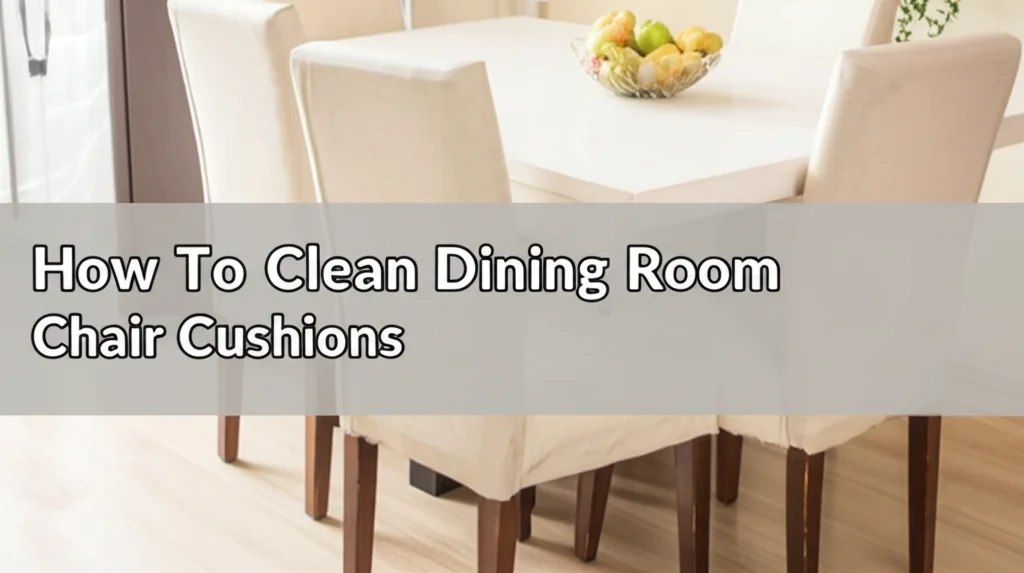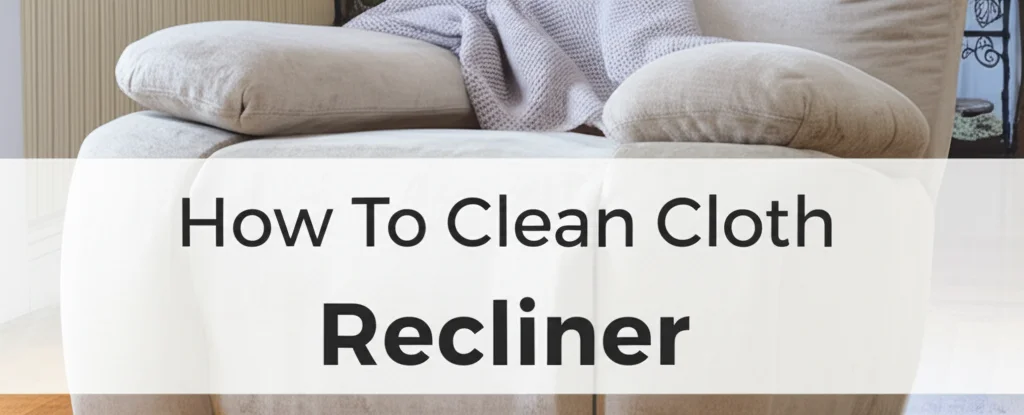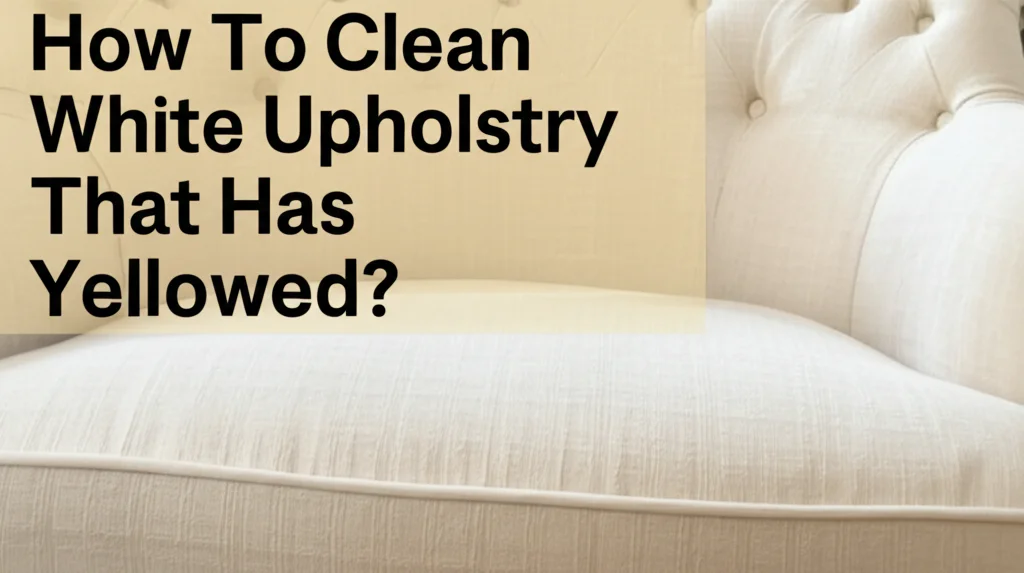· Home Cleaning · 8 min read
How To Clean Dining Room Chair Cushions

Revitalize Your Dining Space: How To Clean Dining Room Chair Cushions
Is your dining room looking a little lackluster? Often, the culprit isn’t the table or the walls, but the chair cushions! Dining room chair cushions gather spills, crumbs, and general wear and tear quickly. Knowing how to clean dining room chair cushions is essential for maintaining a welcoming and hygienic eating space. This guide will walk you through everything you need to know, from identifying fabric types to tackling stubborn stains, ensuring your dining area remains a comfortable and inviting place for family and friends. We’ll cover various cleaning methods, preventative measures, and tips for keeping your cushions looking their best for years to come.
Takeaway:
- Identify your cushion fabric type.
- Vacuum regularly to remove loose debris.
- Spot clean stains immediately.
- Deep clean cushions periodically based on usage.
- Protect cushions with fabric protectors.
Quick Answer:
To clean dining room chair cushions, first identify the fabric. Vacuum to remove loose particles, then spot clean stains with a mild detergent solution. For deeper cleaning, use an upholstery cleaner or a homemade solution of dish soap and water, always testing in an inconspicuous area first. Allow to air dry completely.
Understanding Your Cushion Fabric: The First Step to Cleaning
Before you grab any cleaning supplies, it’s crucial to identify what your dining room chair cushions are made of. Different fabrics require different cleaning approaches. Using the wrong method can damage the material or leave behind unsightly residue. Common dining room chair cushion fabrics include cotton, linen, polyester, microfiber, and vinyl.
- Cotton & Linen: These natural fibers are breathable and comfortable, but they can stain easily. They generally respond well to water-based cleaners.
- Polyester & Microfiber: These synthetic fabrics are durable and stain-resistant. They often require less aggressive cleaning methods.
- Vinyl: Vinyl is waterproof and easy to wipe clean, but it can crack or fade with harsh chemicals.
- Blends: Many cushions are made from fabric blends. Always check the manufacturer’s label for specific cleaning instructions.
Look for a care tag on the cushion itself. This tag will provide valuable information about the fabric content and recommended cleaning methods. If you can’t find a tag, try to determine the fabric type based on its texture and appearance. Knowing your fabric is half the battle when it comes to effective cleaning.
Regular Maintenance: Vacuuming for a Fresh Start
Consistent vacuuming is the cornerstone of keeping your dining room chair cushions clean. It removes loose dirt, dust, crumbs, and pet hair before they become embedded in the fabric. This simple step prevents grime buildup and extends the life of your cushions. Aim to vacuum your chair cushions at least once a week, or more frequently if you have kids or pets.
- Use the Upholstery Attachment: Your vacuum cleaner likely came with an upholstery attachment. This tool is designed to gently lift dirt and debris from fabric surfaces without causing damage.
- Crevice Tool for Tight Spaces: Use the crevice tool to get into seams and tight corners where crumbs and dust tend to accumulate.
- Don’t Forget the Underside: Flip the cushions over and vacuum the underside as well. Dust and debris can collect there too.
- Consider a Lint Roller: For quick touch-ups between vacuuming sessions, a lint roller can effectively remove surface debris.
Regular vacuuming is a proactive step that significantly reduces the need for more intensive cleaning later on. It’s a small effort that yields big results.
Spot Cleaning: Tackling Spills and Stains Immediately
Accidents happen, especially in a dining room! When a spill occurs, act quickly. The longer a stain sits, the harder it will be to remove. Spot cleaning involves treating the affected area with a targeted cleaning solution.
- Blot, Don’t Rub: The most important rule of spot cleaning is to blot the stain, not rub it. Rubbing can spread the stain and damage the fabric.
- Mild Detergent Solution: Mix a small amount of mild dish soap with warm water. Dip a clean cloth into the solution and gently blot the stain.
- Test in an Inconspicuous Area: Before applying any cleaning solution to the stain, test it on a hidden area of the cushion to ensure it doesn’t cause discoloration or damage.
- Rinse with Clean Water: After blotting the stain, rinse the area with a clean, damp cloth to remove any soap residue.
- Dry Thoroughly: Allow the cushion to air dry completely before using it. You can speed up the drying process with a fan.
For tougher stains, like grease or wine, you may need to use a specialized stain remover. Always follow the product instructions carefully. If you’re unsure about tackling a stain yourself, consider professional upholstery cleaning.
Deep Cleaning: Reviving Your Cushions
Even with regular vacuuming and spot cleaning, dining room chair cushions benefit from periodic deep cleaning. This process removes embedded dirt, allergens, and odors, leaving your cushions feeling fresh and revitalized. There are several methods for deep cleaning, depending on your fabric type.
- Upholstery Cleaner: A dedicated upholstery cleaner is a great option for most fabric types. Follow the product instructions carefully, and always test in an inconspicuous area first.
- Homemade Cleaning Solution: For a more natural approach, mix 1/4 cup of dish soap with 1 quart of warm water. Apply the solution to the cushion with a sponge or spray bottle, being careful not to oversaturate the fabric.
- Steam Cleaning: Steam cleaning can effectively sanitize and refresh your cushions. However, it’s not suitable for all fabrics. Check the manufacturer’s instructions before steam cleaning. If you’re unsure, consider professional steam cleaning.
- Air Drying is Key: After deep cleaning, allow the cushions to air dry completely. Avoid direct sunlight, which can fade the fabric. You can use a fan to speed up the drying process.
Deep cleaning should be done every 6-12 months, depending on how frequently the cushions are used. This will help maintain their appearance and extend their lifespan. You might also consider checking out https://beacleaner.com/how-to-clean-luxury-vinyl-plank-flooring/ for tips on keeping your dining room floor clean too!
Dealing with Specific Cushion Types: Vinyl and Outdoor Fabrics
Some dining room chair cushions require specialized cleaning techniques. Vinyl cushions, for example, are waterproof but can be damaged by harsh chemicals. Outdoor fabrics are designed to withstand the elements but may still need occasional cleaning.
- Vinyl Cushions: Wipe vinyl cushions clean with a damp cloth and mild soap. Avoid abrasive cleaners, which can scratch the surface. You can also use a vinyl protectant to help prevent cracking and fading.
- Outdoor Fabrics: Outdoor fabrics are typically water-resistant and fade-resistant. However, they can still accumulate dirt and mildew. Clean outdoor cushions with a mild soap and water solution. You can also use a fabric protector specifically designed for outdoor use.
- Removable Covers: If your cushions have removable covers, check the care label for washing instructions. Many covers can be machine washed on a gentle cycle.
Always follow the manufacturer’s instructions for cleaning specific cushion types. Proper care will ensure your cushions remain in good condition for years to come.
Protecting Your Investment: Preventative Measures
Once you’ve cleaned your dining room chair cushions, take steps to protect them from future stains and damage. Preventative measures can significantly reduce the need for frequent cleaning.
- Fabric Protector: Apply a fabric protector to your cushions to repel spills and stains.
- Regular Vacuuming: Continue to vacuum your cushions regularly to remove loose dirt and debris.
- Cushion Covers: Consider using cushion covers to protect your cushions from spills and wear and tear.
- Avoid Direct Sunlight: Prolonged exposure to direct sunlight can fade the fabric. Position your dining table away from direct sunlight or use curtains or blinds to filter the light.
- Promptly Address Spills: As mentioned earlier, act quickly when a spill occurs. The faster you address the stain, the easier it will be to remove.
Taking these preventative measures will help keep your dining room chair cushions looking their best for years to come. You might also find helpful tips on floor care at https://beacleaner.com/how-to-clean-hardwood-floors-with-vinegar/.
Frequently Asked Questions (FAQ)
Q: Can I use bleach to clean my dining room chair cushions?
A: Generally, no. Bleach can damage most fabrics and cause discoloration. It’s best to stick to mild detergents and cleaning solutions specifically designed for upholstery. Always test in an inconspicuous area first.
Q: How do I remove mold from my dining room chair cushions?
A: Mix a solution of equal parts water and white vinegar. Apply to the affected area, let it sit for 15-20 minutes, then scrub gently with a soft brush. Rinse with clean water and allow to air dry completely. If the mold is extensive, consider professional cleaning.
Q: What’s the best way to dry my chair cushions after cleaning?
A: Air drying is the safest method. Avoid direct sunlight or heat, which can damage the fabric. Use a fan to speed up the drying process. Ensure the cushions are completely dry before using them.
Q: Can I use a carpet cleaner on my dining room chair cushions?
A: While some carpet cleaners can be used on upholstery, it’s crucial to check the product label and test in an inconspicuous area first. Some carpet cleaners contain harsh chemicals that can damage certain fabrics.
Conclusion: Enjoy a Sparkling Clean Dining Room
Cleaning your dining room chair cushions doesn’t have to be a daunting task. By understanding your fabric type, implementing a regular cleaning routine, and addressing spills promptly, you can keep your cushions looking fresh and inviting for years to come. Remember, consistent maintenance is key to preventing grime buildup and extending the life of your cushions. So, go ahead and give your dining room a refresh – you deserve a comfortable and stylish space to enjoy meals with family and friends! Don’t forget to also consider the cleanliness of your floors; you can find helpful advice on removing tough stains at https://beacleaner.com/how-to-get-grease-out-of-carpet/.




